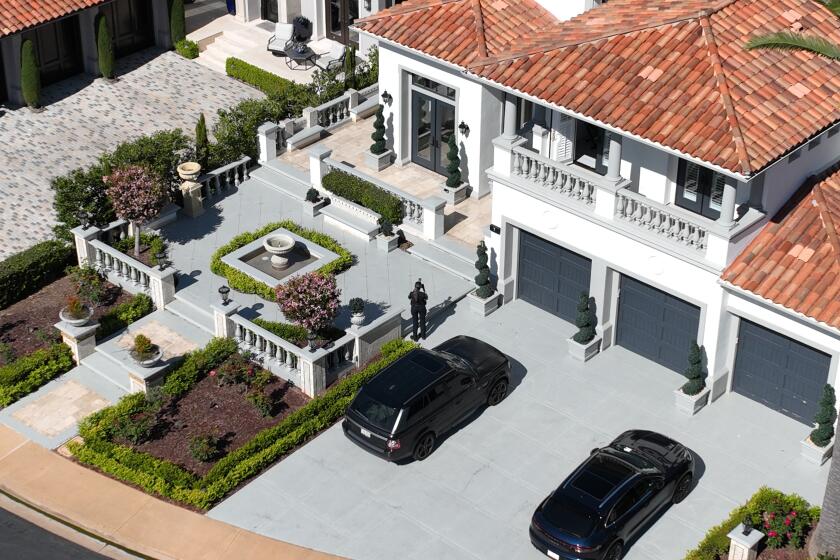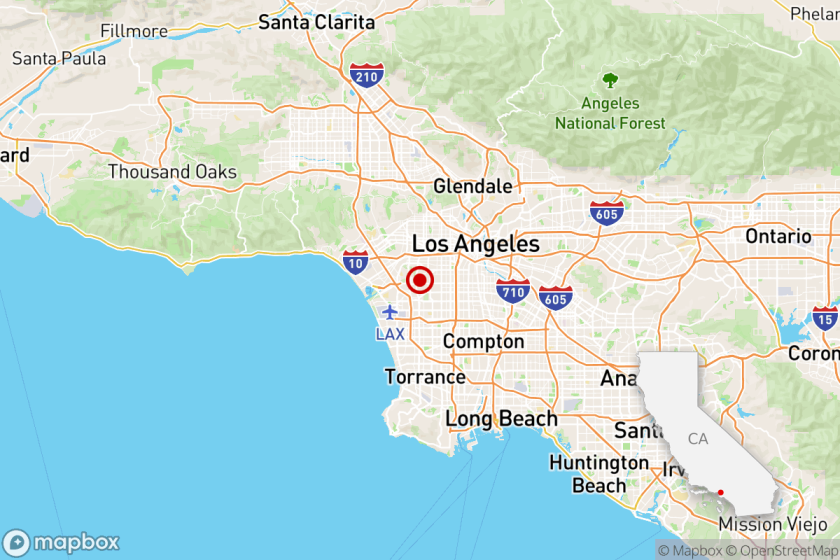‘Monster’ Sought in a Dozen Killings
A northeast Los Angeles gang leader described by police as a thrill killer is wanted in connection with 12 homicides, placing him on the city’s all-time roster of suspected multiple murderers.
Over the last five years, Timothy Joseph McGhee has either overseen or pulled the trigger in the executions of gang rivals, witnesses and others simply unlucky enough to have crossed his path, police allege.
McGhee, 29, has spent a third of his life behind bars, but for the last 13 months he has managed to elude both police and notoriety.
Authorities have offered $5,000 to anyone who can help them find McGhee, and another $50,000 for information leading to his arrest and conviction.
Charles Manson “killed seven people, and it was national news,” said Los Angeles Police Department Det. Andy Teague. “This guy could rank up there with the worst of the worst. The difference is, this case hasn’t gotten the publicity.”
He said McGhee has targeted unarmed and defenseless people, often going on hunting expeditions with fellow gang members. “He likes killing people; it’s his high and he does it for kicks,” Teague said.
McGhee is on the U.S. Marshals Service’s 15 most-wanted fugitives list.
Police said McGhee runs the Toonerville gang, whose mostly Latino members claim a largely middle-class area that includes business warehouses and $300,000 homes north of Los Feliz Boulevard between San Fernando Road and the Los Angeles River. The gang, formed in the late 1950s, also has members in Glendale, Sunland and Tujunga.
McGhee was convicted in 1994 of assaulting a peace officer in San Bernardino County and sentenced to four years in prison. He was released after serving three years, and then sent back to prison in 1997 on a parole violation. He was released in March 1999, violated parole again and was returned to prison in February 2000. He was released two months later. Police suspect that McGhee killed a rival gang member in 1997 and a bodyguard for a rap artist at an Atwater music studio in 1999.
McGhee was “out hunting” with fellow gang members on June 3, 2000, when they allegedly killed 16-year-old Ryan Gonzales, Teague said. “When they go into rival territory, it’s like a hunter going into a big-game preserve,” he said.
Gonzales happened to share McGhee’s street name of Guero -- a Spanish nickname for someone light-skinned. He was walking home from a party in the 3300 block of Silver Lake Boulevard when police say McGhee and others fatally shot him. Investigators said they believe one reason is that McGhee didn’t think the area was big enough for two people with the same nickname.
McGhee also is alleged to have fatally shot a 17-year-old boy, Marty Gregory Roybal, who was sketching a picture at the Los Angeles River on Sept. 14, 2000, and then, seeing that a nearby homeless man -- David Lamont Martin, 33 -- might have been a witness, is alleged to have killed him too.
McGhee’s killings accelerated during the summer of 2001, police said.
That June 12, McGhee is suspected of fatally shooting a Pomona resident, Manuel Apodaca, 21, and critically wounding his pregnant girlfriend, Nina Guerrero, on Los Feliz Boulevard near the Golden State Freeway. Guerrero suffered severe brain damage, but was able to give birth.
The couple allegedly made money by robbing drug dealers, Teague said, and McGhee is believed to have shot them when they tried to rob him.
The next month, McGhee ordered the killing of Carlos Velasco, a 21-year-old man working at a furniture warehouse on San Fernando Road, police said. McGhee had passed by and didn’t recognize the man, police said, so he ordered gang subordinates “to take care of” the stranger.
Less than three weeks later, McGhee allegedly killed Bryham Robinson, 38; Cheri Wisotsky, 46; and her mother, Mary Ann Wisotsky, 64. McGhee had heard that Cheri Wisotsky had told police about drug dealing at the house where McGhee’s sister lived. Authorities allege the others were killed because they were witnesses. McGhee’s family declined to comment for this story.
In November 2001, McGhee and fellow gang members, armed with handguns and assault rifles, went looking to kill a victim in rival territory, police said -- revenge for the earlier slaying of a Toonerville member.
They spotted a sport utility vehicle and decided its occupants would be their next victims, police said. McGhee and his associates allegedly cut off the SUV and then fatally shot Margie Mendoza, a mother of two, and wounded her husband in the 3100 block of Hollydale Drive. “They murdered the first people they saw,” Teague said. “For them, it didn’t matter if it was a guy watering his lawn or a kid skateboarding down the street. All that’s necessary is that the victim is in the rival gang’s territory.”
McGhee has many gang tattoos, including an eagle and a snake from the Mexican flag emblazoned across the back of his head. “Atwater Village” appears on his chest and “Toonerville Rifa” on his back, according to his police wanted poster.
Teague said investigators have had difficulty persuading witnesses to cooperate. McGhee’s deadly reputation intimidates residents, rival gang members and his own associates, Teague said.
“People know you don’t cross McGhee,” said Teague, who along with seven other LAPD detectives has been working on the case for two years. “There are no ifs, ands or buts about it. If you cross him, you’re dead.”
McGhee runs his gang like a paramilitary group, posting armed sentries equipped with cell phones or walkie-talkies to watch streets in their neighborhood, police said.
He demands absolute loyalty and leads his followers in calisthenics and target shooting and schools them in tactics. Gang crime in Atwater Village has risen and fallen, Teague said, depending on whether McGhee is in prison or free. “Basically, he’s a monster,” Teague said.
*
Times staff writer Akilah Johnson contributed to this report.
More to Read
Start your day right
Sign up for Essential California for news, features and recommendations from the L.A. Times and beyond in your inbox six days a week.
You may occasionally receive promotional content from the Los Angeles Times.







